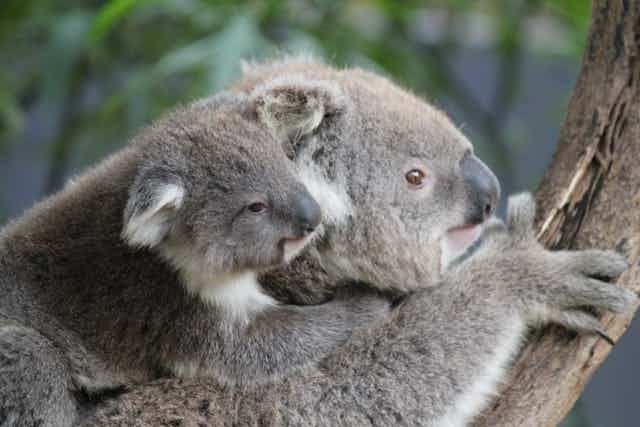Keeping cool during summer can be difficult, but new research published in Biology Letters shows that koalas cope with high temperatures in an unusual way – by hugging trees.
Researchers used thermal imaging and microclimate data to show that koalas regulate their body temperature in summer by resting their bodies against cool tree trunks.
“This makes us recognise the importance of non-food trees [to koalas],” said Michael Kearney from the University of Melbourne, one of the study’s authors. “They provide them with an important microclimate to cool down during heatwaves.”
Keeping it cool
The researchers observed koalas on French Island, Victoria, resting their bodies against tree trunks during hot weather, and so set out to understand why.
They used a portable weather station on a pole to measure what temperatures koalas were experiencing on their chosen trees. They also used a thermal imaging camera to measure the tree trunks themselves.
Their data showed the trunks of certain large trees were up to 5C cooler than the surrounding air.

“We’re not 100% sure why the trees are so much cooler,” Dr Kearney said. “In part it might be due to the groundwater they’re drawing up through the trunks, which transpires through their leaves.”
Koalas, like many other animals, also cool themselves by panting and licking their fur, but this can lead to dehydration. Hugging tree trunks allows them to keep cool without losing too much water.
“A lot of the time, they’re just flopped on the horizontal limb [of the tree], their limbs dangling downwards,” Dr Kearney said. “They’re trying to maximise the surface area of the belly touching the tree limb.”
Adapting to hot and cold

Koalas in Australia’s southern states are much larger and have longer fur than their northern relatives, which is believed to be an adaptation for cooler climates.
But Dr Kearney said the southern koalas must still endure a range of environmental and weather conditions.
“They are stuck out there no matter what the weather is ‒ they don’t have a tree hollow or burrow to go into ‒ so they need to have a coat for all seasons,” Dr Kearney said.
“This is a challenge for them: natural selection ends up with a body and physiology that on average work best for all those conditions. It’s a real tug-of-war of natural selection on many aspects of the koala.”
So this tree-hugging behaviour may be vital in that it allows koalas to survive in the extreme heat without sacrificing the warm fur they need for winter.
“It’s an interesting approach to look at behavioural adaptations to physiological problems,” William Ellis, a wildlife researcher at University of Queensland, said.
“I’ve approached a number of physiologists about how you’d actually work out what kind of advantage a koala might get from utilising trees as heat sinks.
"I don’t think many physiologists thought it was going to make a significant contribution to thermoregulation in the koala. I think it’s pretty clear from this study that it does.”
Heat extremes set to rise
Koalas aren’t the only Australian mammals to have discovered the cooling benefits of tree trunks.
“We have observed very similar behaviour in flying-foxes during extremely hot days in eastern Australia,” Justin Welbergen, an evolutionary ecologist at University of Western Sydney, said.
“During such events flying-foxes also hug trees, and like koalas will seek out the coolest available microenvironments.”
Such cooling behaviours may prove crucial in the future, with the frequency and intensity of heatwaves expected to increase with climate change.
“What this research means is that even though future temperatures may be a lot higher on these extremely hot days, the temperature [experienced by the koala] is being buffered by the tree trunks in their environment,” Dr Welbergen said.
“These sorts of strategies, where animals exploit cooler spots in their environment, will soften some of the impacts of extreme events on biodiversity. So in that sense it’s quite important.”

